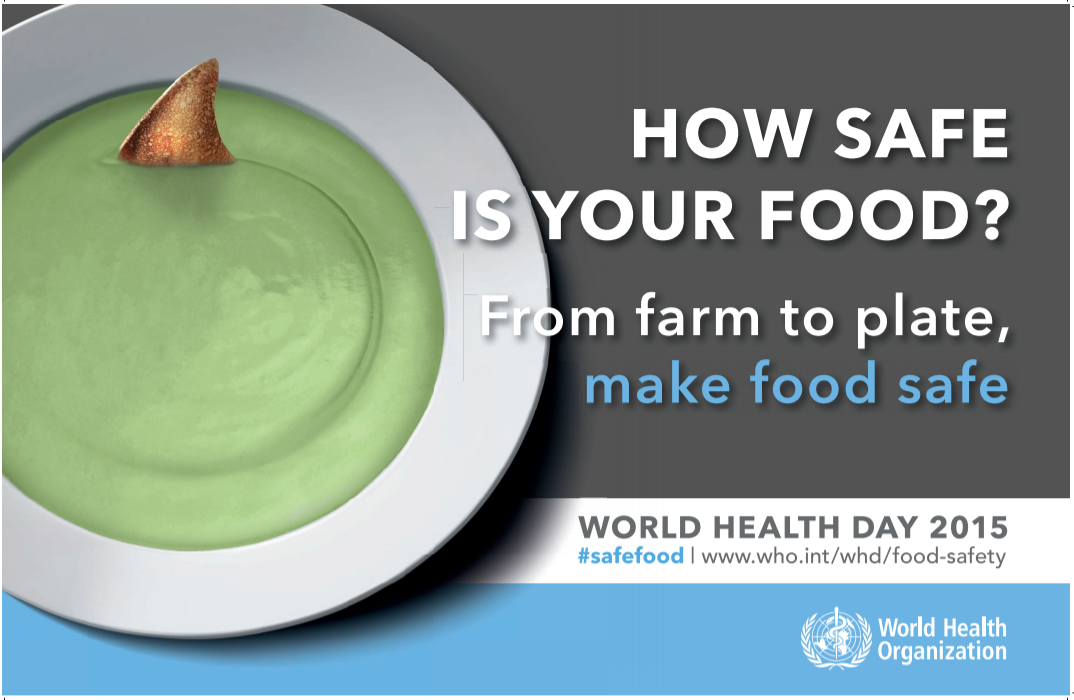
Theme: Food safety
Every year, the World Health Organization selects a priority area of global public health concern as the theme for World Health Day, which falls on 7 April, the birthday of the Organization.
Background
Unsafe food is linked to the deaths of an estimated 2 million people annually – including many children. Food containing harmful bacteria, viruses, parasites or chemical substances is responsible for more than 200 diseases, ranging from diarrhoea to cancers.
New threats to food safety are constantly emerging. Changes in food production, distribution and consumption; changes to the environment; new and emerging pathogens; antimicrobial resistance - all pose challenges to national food safety systems. Increases in travel and trade enhance the likelihood that contamination can spread internationally.
The topic for World Health Day 2015 is food safety
The theme for World Health Day 2015 will be Food Safety, a theme of high relevance to all people on the planet, and multiple stakeholders, including government, civil society, the private sector, and intergovernmental agencies.
Safe food underpins but is distinct from food security. Food safety is an area of public health action to protect consumers from the risks of food poisoning and foodborne diseases, acute or chronic. Unsafe food can lead to a range of health problems: diarrhoeal disease, viral disease (the first Ebola cases were linked to contaminated bush meat); reproductive and developmental problems, cancers.
As our food supply becomes increasingly globalized, the need to strengthen food safety systems in and between all countries is becoming more and more evident. Food safety is thus a prerequisite for food security. New threats to food safety are constantly emerging. Changes in food production, distribution and consumption (i.e. intensive agriculture, globalization of food trade, mass catering and street food); changes to the environment; new and emerging bacteria and toxins; antimicrobial resistance—all increase the risk that food becomes contaminated. Increases in travel and trade enhance the likelihood that contamination can spread. The World Health Organization helps and encourages countries to prevent, detect and respond to foodborne disease outbreaks—in line with the Codex Alimentarius, a collection of international food standards, guidelines and codes of practice covering all the main foods. Recognising that food safety is a cross-cutting issue and shared responsibility, the World Health Organization welcomes the participation of non-public health sectors (i.e. agriculture, trade and commerce, environment, standardization) in this campaign and seeks support of major international and regional agencies and organizations active in the fields of food, emergency aid, and education.
World Health Day 2015 is an opportunity to alert governments, manufacturers, retailers and the public to the importance of food safety—and the part each can play in ensuring that the food on peoples’ plates is safe to eat.
The campaign aims to:
- Spur governments to improve food safety through public awareness campaigns and highlight their ongoing actions in this area
- Encourage consumers to ensure the food on their plate is safe (ask questions, check labels, follow hygiene tips)
Five keys to safer food
Food safety is a shared responsibility. It is important to work all along the food production chain – from farmers and manufacturers to vendors and consumers. For example, WHO’s Five keys to safer food offer practical guidance to vendors and consumers for handling and preparing food:
- Key 1: Keep clean
- Key 2: Separate raw and cooked food
- Key 3: Cook food thoroughly
- Key 4: Keep food at safe temperatures
- Key 5: Use safe water and raw materials.
World Health Day 2015 is an opportunity to alert people working in different government sectors, farmers, manufacturers, retailers, health practitioners – as well as consumers – about the importance of food safety, and the part each can play in ensuring that everyone can feel confident that the food on their plate is safe to eat.
Video: How safe is your food?
Video: Global view of food safety
